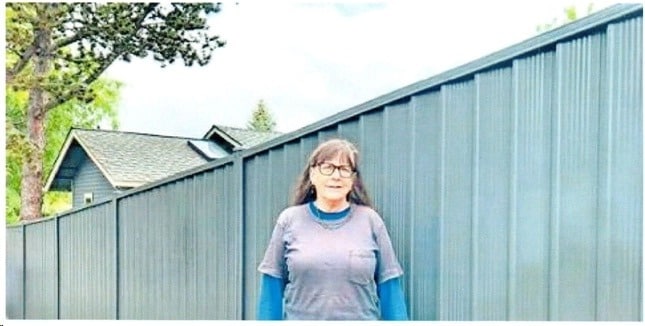Retired forest firefighter Mary Kwart stands in front of a new steel fence that replaced a wood one separating her Ashland property from her neighbor’s. In the future, Kwart might add steel exterior shutters she can pull down over windows to keep heat from an outside fire from shattering the glass. Janet Eastman, staff
Janet Eastman – The Oregonian/OregonLive
‘I don’t know which precaution will save my house, so I do as m uch as I can.’
Mary Kwart has faced wildfires and knows their power. The retired forest firefighter has an evacuation plan if a blaze barrels down the street to her Ashland home, but she’s not giving up without a fight.
Her fire prevention projects are big and small, and cost from thousands of dollars to nothing except her time and effort.
“There’s no silver bullet,” she said recently, standing in front of a new steel fence that replaced a wood one separating her property from her neighbor’s. “I don’t know which precaution will save my house, so I do as much as I can.”
Predictions of a dry, hot summer fuel concern about another devastating wildfire season, causing many people to focus on fire suppression to reduce the vulnerability of their home and community.
Portland General Electric and other electricity providers are gearing up for preemptive blackouts during the 2021 wildfire season, which began May 15 for some parts of the state most heavily impacted by drought.
Wildfires in Oregon last year burned almost 1 million acres, destroyed thousands of homes and businesses, and left nine people dead.
The extraordinary conflagrations affected most Orego nians, from those who lost everything to people forced to breathe smoky air, said Oregon State University Extension fire specialist Amanda Rau in a Wildfire Wednesdays webinar recorded March 31.
Kara Baylog with OSU’s College of Forestry explained in the webinar that more than 90% of homes in a wildfire are burned by embers that can travel a mile or more depending on wind.
Embers gain strength when they accumulate through gaps in a home or ignite leaves and debris that collect in rain gutters and on a roof, said Baylog.
Outside Kwart’s 1950 cottage, workmen were painting newly installed HardiePlank fiber cement siding that replaced the old, combustible cedar board and-batten on exterior walls.
Kwart also had the eaves enclosed and openings in exterior walls covered with 1/8-inch metal screens to block embers. Metal covers will keep leaves and pine needles, which could dry and become fuel for fire, out of rain gutters.
Other small but strategic improvements include removing wood garden borders and putting in strips of corrugated steel landscape edging.
Her next job: Taking bark mulch, dried leaves and other flammable garden debris out of her yard.
In the future, Kwart might add steel exterior shutters she can pull down over windows to keep heat from an outside fire from shattering the glass, “like putting boiling water in a chilled glass,” explained Baylog.
“Steel shutters, removing vegetation to take away close contact to flame and using double- or triple-paned windows can alleviate that,” Baylog said.
Kwart’s experience has taught her that structures may survive as a fire moves through the area but burn down afterward due to spot fires that could have been extinguished.
“Fire’s impact is expanding, it’s not going away,” said Kwart, who spent five weeks fighting the 1988 Yellowstone fires and other historic blazes during her 30- year career. “We’re past the point of relying on heroes to rescue us. We need to be our own heroes for us and our community.”
Experts agree that the right actions can help keep you and your household safe and save your property, and possibly your neighbors’, from destruction.
Oregon’s Defensible Space law requires that landowners reduce excess vegetation around structures. Depending on the risk of fire , some areas also require fuel breaks along property lines and roadsides.
Fines can rise to $100,000 for negligent landowners next to forestland who contribute to a fire, according to the Oregon Forestland Urban Interface Fire Protection Act. The city of Portland can pass the full cost of controlling and cleaning up a fire to the person responsible.
Portland Fire & Rescue has a safety checklist for inside a home that includes
removing clutter and other unnecessary combustible, s and making sure
electrical and heating equipment are in good working condition and not overheating .
Smoke alarms are required , but fire experts also recommend people have fire extinguishers and an escape plan.
Landscaping Red Flags
Visitors to the Fire Safety House, a remodeled dwelling at the Oregon Garden in Silverton , can wander around what fire educators call a “life-sized teaching tool” and see ways to buy time until firefighters arrive.
The landscaping demonstrates how to keep land lean, clean and green by: planting low flammability species
spacing plants farther apart and in small, irregular islands pruning, thinning and removing dead or high-risk vegetation
irrigating low-growing, high-moist ure plants to slow or stop ground fires
No plant is fireproof, but many are more difficult to ignit e. OSU Extension has a free downloadable guide, “Fire-resistant Landscape Plants for the Willamette Valley,” of recommended ground covers, perennials, shrubs and trees at bit.ly/osu-fire-resistant.
There is also a free app for Android and Apple devices.
An easy test: Highly flammable plants have gummy sap and leaves that have a strong odor when crushed. Do n’t have plants with a high oil, aromatic or resin content or ones that produce fine , dry or dead leaves or needles.
Old trees are more resilient to damage from wildfires and if pruned can act as a living wall that reduces fire’s intense heat and blocks airborne embers, according to the state ‘s forestry experts.
To prevent a ground fire from climbing and spreading, remove tree branches that hang over a house and that are lower than six feet from the ground. Also cut back other “ladder fuels,” vegetation that serves as a link between grass and treetops.
Decks and Other Potential Hazards
A fire hazard can be as quaint as a wood picket fence.
Oregon Department of Forestry tells homeowners who insist on having an all wood fence to use masonry or metal as a protective barrier between the fence and the house.
The agency recommends that a wooden deck not be on top of a slope, potentially in the direct line of a fire that burns hotter and moves faster uphill.
Decks should be made of fire-treated wood boards and have nothing stored underneath them that can catch fire. Metal wire mesh no larger than an 1/8 inch can prevent dry leaves from collecting and embers from starting a fire underneath a deck.
Firewood and propane tanks should be stored away from any st ructu re.
Experts also recommend that you create a fire break with driveways, gravel paths and green lawns, and make sure your address numbers are clearly visible to emergency responders trying to find you.
The goal is to lessen the risk by maintaining a defensible space that does not add fuel to a fire.
“In the end, remember no one is an island. Your landscape is only as defensible against fire as your neighbors’ landscape and maintenance is crucial,” said Bonnie Bru ce, who owns Celilo Gardens, a landscape design studio in Portland.
Bruce, a certified Master Gardener and member of Oregon’s Association of Professional Landscape Designers, tells people attending her fire-scaping classes that it’s no fun to clean up a yard or hack through a bramble of flammable blackberries.
“But organizing a neighborhood work party to do the job changes all of that,” she said.
“Lending a hand lightens the load for everyone. It builds community and initiates friendships, all of which become critical in an emergency.”
503-294-4 072 , jeastman@oregonian.com @janeteastman

